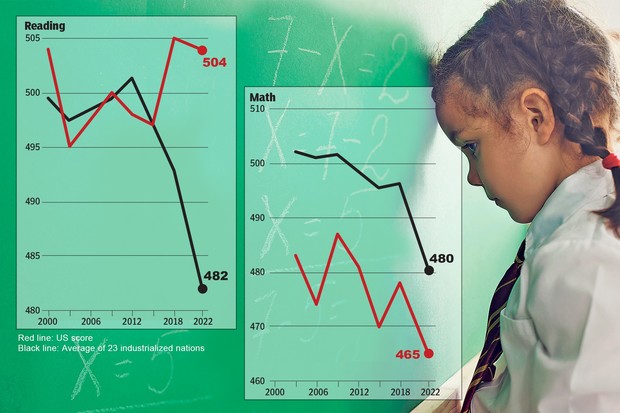Media Bias Alert: Media Across Spectrum Show Negativity Bias Toward U.S. Test Scores

Statistics from the Organisation for Economic Co-operation and Development’s (OECD) Programme for International Student Assessment (PISA) released this week showed students across the developed world struggling with math, including American students, who achieved an all-time low average score.
Many mainstream media outlets across the spectrum covered the story, and showed media bias, particularly negativity bias, in the framing of how U.S. students performed.
Since the last assessment in 2018, U.S. students remained nearly stable in reading (minus one point) and science (minus three points), while dropping 13 points in mathematics. Despite being in the red, all three of these results actually improved the United States’ ranking in each subject, relative to the other 80 countries tested. The U.S. improved worldwide from 29th to 26th in math, eighth to sixth in reading, and eleventh to tenth in science.
Not only did the U.S. weather the storm slightly better than other participating countries, but its negative net trends trailed the falling OECD averages as well. Compared to the OECD averages (which are based on 23-country summations of OECD data sets that date back to the early 2000s), the field dropped approximately 10 points in reading, three points in science, and 15 points in math.
Despite remaining nearly stable in the reading and science portions of the assessment, almost all mainstream outlets AllSides found that produced original coverage of the story framed headlines by focusing on American students’ poor performance in math.
Beyond headlines, several publications omitted key context altogether.
While reviewing coverage, AllSides analyzed the presence or absence of three integral story elements:
| Outlet | Stable in Reading + Science | Math Scores Declining Globally |
U.S. Rose in Global Math Rankings |
| The Daily Caller (Right) | |||
| Axios (Lean Left) | X | ||
| National Review (Lean Right) | X | ||
| Newsweek (Center) | X | X | |
| Forbes (Center) | X | X | |
| NewsNation (Center) | X | X | |
| Reason (Lean Right) | X | X | |
| Washington Post (Lean Left) | X | X | X |
| New York Times (Lean Left) | X | X | X |
| Associated Press (Lean Left) | X | X | X |
| Wall Street Journal (Center) | X | X | X |
| New York Post (Lean Right) | X | X | X |
| Daily Mail (Right) | X | X | X |
The PISA report found countries that endured less time in lockdown and/or had better remote learning infrastructure were more likely to achieve better test scores, which was something several outlets included in their coverage.
Outlets across the spectrum also highlighted a variety of expert opinions on the falling scores, including the perspective of U.S. Education Secretary Miguel Cardona, who attributed the relative success to President Joe Biden’s investments in education, including $190 billion in pandemic relief that Congress sent to schools.
The Wall Street Journal noted that PISA researchers said exam participation in the U.S. is voluntary, which could affect the statistics. The Journal said private school participation was “particularly low.”
Newsweek’s coverage included an error, which made its coverage appear more negative than it would have if correct. It said the U.S. fell to 26th in the global math rankings when it actually climbed to 26th.
Andy Gorel is an AllSides News Editor and Bias Analyst. He has a Center bias.
This piece was reviewed by Joseph Ratliff, AllSides News Editor and Content Designer (Lean Left bias), and Julie Mastrine, Director of Marketing and Media Bias Ratings (Lean Right bias).

April 26th, 2024

April 25th, 2024

April 25th, 2024